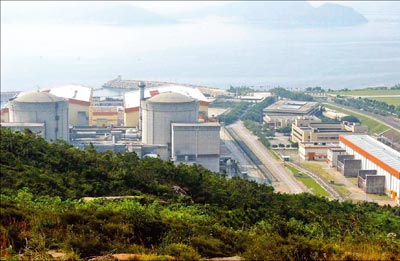
Image credit: IHEP.
The Daya Bay Reactor Neutrino Experiment has begun its quest to answer some of the puzzling questions that still remain about neutrinos. The experiment’s first completed set of twin detectors is now recording interactions of antineutrinos as they travel away from the powerful reactors of the China Guangdong Nuclear Power Group, in southern China.
The start-up of the Daya Bay experiment marks the first step in the international effort of the Daya Bay collaboration to measure a crucial quantity related to the third type of oscillation, in which the electron-neutrinos morph into the other two flavours of neutrino. This transformation occurs through the least known neutrino-mixing angle, θ13, and could reveal clues leading to an understanding of why matter predominates over antimatter in the universe.
The experiment is well positioned for a precise measurement of the poorly known value of θ13 because it is close to some of the world’s most powerful nuclear reactors – the Daya Bay and Ling Ao nuclear power reactors, located 55 km from Hong Kong – and it will take data from a total of eight large, virtually identical detectors in three experimental halls deep under the adjacent mountains. Experimental Hall 1, a third of a kilometre from the twin Daya Bay reactors, is the first to start operating. Hall 2, about a half kilometre from the Ling Ao reactors, will come online in the autumn. Hall 3, the furthest hall, about 2 km from the reactors, will be ready to take data in the summer of 2012.
The Daya Bay experiment is a “disappearance” experiment. The detectors in the two closest halls will measure the flux of electron-antineutrinos from the reactors; the detectors at the far hall will look for a depletion in the expected antineutrino flux. The cylindrical antineutrino detectors are filled with liquid scintillator, while sensitive photomultiplier tubes line the detector walls, ready to amplify and record the telltale flashes of light produced by the rare antineutrino interactions. As a result of the large flux of antineutrinos from the reactors, the twin detectors in each hall will capture more than 1000 interactions a day, while at their greater distance the four detectors in the far hall will measure only a few hundred interactions a day. To measure θ13, the experiment records the precise difference in flux and energy distribution between the near and far detectors.
The experimental halls are deep under the mountain to shield the detectors from cosmic rays and the detectors themselves are submerged in pools of water to shield them from radioactive decays in the surrounding rock. Energetic cosmic rays that make it through the shielding are tracked by photomultiplier tubes in the walls of the water pool and muon trackers in the roof over the pool so that events of this kind can be rejected.
After two to three years of collecting data with all eight detectors, the Daya Bay Reactor Neutrino Experiment should be well positioned to meet its goal of measuring the electron-neutrino oscillation amplitude – and hence sin2 2θ13 – with a sensitivity of 1%.
The start up of the experiment begins after eight years of effort – four years of planning and four years of construction – by hundreds of physicists and engineers from around the globe. China and the US lead the Daya Bay collaboration, which also includes participants from Russia, the Czech Republic, Hong Kong and Taiwan. The Chinese effort is led by project manager Yifang Wang of the Institute of High Energy Physics (IHEP), Beijing, and the US effort is led by project manager Bill Edwards of Lawrence Berkeley National Laboratory and chief scientist Steve Kettell of Brookhaven National Laboratory.





